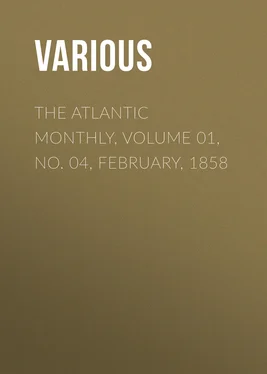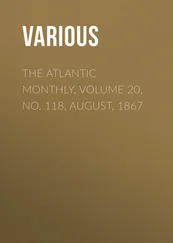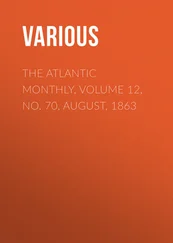Various - The Atlantic Monthly, Volume 01, No. 04, February, 1858
Здесь есть возможность читать онлайн «Various - The Atlantic Monthly, Volume 01, No. 04, February, 1858» — ознакомительный отрывок электронной книги совершенно бесплатно, а после прочтения отрывка купить полную версию. В некоторых случаях можно слушать аудио, скачать через торрент в формате fb2 и присутствует краткое содержание. Жанр: foreign_antique, periodic, foreign_edu, на английском языке. Описание произведения, (предисловие) а так же отзывы посетителей доступны на портале библиотеки ЛибКат.
- Название:The Atlantic Monthly, Volume 01, No. 04, February, 1858
- Автор:
- Жанр:
- Год:неизвестен
- ISBN:нет данных
- Рейтинг книги:3 / 5. Голосов: 1
-
Избранное:Добавить в избранное
- Отзывы:
-
Ваша оценка:
- 60
- 1
- 2
- 3
- 4
- 5
The Atlantic Monthly, Volume 01, No. 04, February, 1858: краткое содержание, описание и аннотация
Предлагаем к чтению аннотацию, описание, краткое содержание или предисловие (зависит от того, что написал сам автор книги «The Atlantic Monthly, Volume 01, No. 04, February, 1858»). Если вы не нашли необходимую информацию о книге — напишите в комментариях, мы постараемся отыскать её.
The Atlantic Monthly, Volume 01, No. 04, February, 1858 — читать онлайн ознакомительный отрывок
Ниже представлен текст книги, разбитый по страницам. Система сохранения места последней прочитанной страницы, позволяет с удобством читать онлайн бесплатно книгу «The Atlantic Monthly, Volume 01, No. 04, February, 1858», без необходимости каждый раз заново искать на чём Вы остановились. Поставьте закладку, и сможете в любой момент перейти на страницу, на которой закончили чтение.
Интервал:
Закладка:
The mechanical processes by which Nature is so closely imitated, and the increase of which during the last few years is one of the most remarkable facts in science, may at the first glance appear to have lessened the marvellous in Art, by making available to all the exact representation of still-life. But, when duly considered, the effect is precisely the reverse; for exactly in proportion as we become familiar with the mechanical production of the similitudes of natural and artificial objects, do we instinctively demand higher powers of conception, greater spiritual expression in the artist. The discovery of Daguerre and its numerous improvements, and the unrivalled precision attained by Photography, render exact imitation no longer a miracle of crayon or palette; these must now create as well as reflect, invent and harmonize as well as copy, bring out the soul of the individual and of the landscape, or their achievements will be neglected in favor of the fac-similes obtainable through sunshine and chemistry. The best photographs of architecture, statuary, ruins, and, in some cases, of celebrated pictures, are satisfactory to a degree which has banished mediocre sketches, and even minutely finished but literal pictures. Specimens of what is called "Nature-printing," which gives an impression directly from the veined stone, the branching fern, or the sea-moss, are so true to the details as to answer a scientific purpose; natural objects are thus lithographed without the intervention of pencil or ink. And these several discoveries have placed the results of mere imitative art within reach of the mass; in other words, her prose language, that which mechanical science can utter, is so universal, that her poetry, that which must be conceived and expressed through individual genius, the emanation of the soul, is more distinctly recognized and absolutely demanded from the artist, in order to vindicate his claim to that title, than ever before.
Perhaps, indeed, the scope which Painting offers to experimental, individual, and prescriptive taste, the loyalty it invokes from the conservative, the "infinite possibilities" it offers to the imaginative, the intimacy it promotes with Nature and character, are the cause of so much originality and attractiveness in its votaries. The Lives of Painters abound in the characteristic, the adventurous, and the romantic. Open Vasari, Walpole, or Cunningham, at random, and one is sure to light upon something odd, genial, or exciting. One of the most popular novelists of our day assured me, that, in his opinion, the richest unworked vein for his craft, available in these days of civilized uniformity, is artist-life at Rome, to one thoroughly cognizant of its humors and aspirations, its interiors and vagrancies, its self-denials and its resources. I have sometimes imagined what a story the old white dog who so long frequented the Lepri and the Caffè Greco, and attached himself so capriciously to the brother artists of his deceased master, could have told, if blest with memory and language. He had tasted the freedom and the zest of artist-life in Rome, and scorned to follow trader or king. He preferred the odor of canvas and oil to that of conservatories, and had more frolic and dainty morsels at an al fresco of the painters, in the Campagna, than the kitchen of an Italian prince could furnish. His very name betokened good cheer, and was pronounced after the manner of the pert waiters who complacently enunciate a few words of English. Bif-steck was a privileged dog; and though occasionally made the subject of a practical joke, taught absurd tricks, sent on fools' errands, and his white coat painted like a zebra, these were but casual troubles; he was a sensible dog to despise them, when he could enjoy such quaint companionship, behold such experiments in color and drawing, serve as a model himself, and go on delicious sketching excursions to Albano and Tivoli, besides inhaling tobacco-smoke and hearing stale jests and love soliloquies ad infinitum . I am of Bif-steck's opinion. There is no such true, earnest, humorous, and individual life, in these days of high civilization, as that of your genuine painter; impoverished as it often is, baffled in its aspirations, unregarded by the material and the worldly, it often rears and keeps pure bright, genial natures whose contact brings back the dreams of youth. It is pleasant, too, to realize, in a great commercial city, that man "does not live by bread alone," that fun is better than furniture, and a private resource of nature more prolific of enjoyment than financial investments. It is rare comfort, here, in the land of bustle and sunshine, to sit in a tempered light and hear a man sing or improvise stories over his work, to behold once more vagaries of costume, to let the eye rest upon pictorial fragments of Italy,—the "old familiar faces" of Roman models, the endeared outlines of Apennine hills, the contadina bodice and the brigand hat, until these objects revive to the heart all the romance of travel.
The technicalities of Art, its refinements of style, its absolute significance, are, indeed, as dependent for appreciation on a special endowment as are mathematics; but the general and incidental associations, in which is involved a world of poetry, may be enjoyed to the full extent by those whose perception of form, sense of color, and knowledge of the principles of sculpture, painting, music, and architecture are notably deficient. It is a law of life and nature, that truth and beauty, adequately represented, create and diffuse a limitless element of wisdom and pleasure. Such memorials are talismanic, and their influence is felt in all the higher and more permanent spheres of thought and emotion; they are the gracious landmarks that guide humanity above the commonplace and the material, along the "line of infinite desires." Art, in its broad and permanent meaning, is a language,—the language of sentiment, of character, of national impulse, of individual genius; and for this reason it bears a lesson, a charm, or a sanction to all,—even those least versed in its rules and least alive to its special triumphs. Sir Walter Scott was no amateur, yet, through his reverence for ancestry and his local attachments, portraiture and architecture had for him a romantic interest. Sydney Smith was impatient of galleries when he could talk with men and women, and made a practical joke of buying pictures; yet Newton and Leslie elicited his best humor. Talfourd cared little and knew less of the treasures of the Louvre, but lingered there because it had been his friend Hazlitt's Elysium. Indeed, there are constantly blended associations in the history of English authors and artists; Reynolds is identified with Johnson and Goldsmith, Smibert with Berkeley, Barry with Burke, Constable and Wilkie with Sir George Beaumont, Haydon with Wordsworth, and Leslie with Irving; the painters depict their friends of the pen, the latter celebrate in verse or prose the artist's triumphs, and both intermingle thought and sympathy; and from this contact of select intelligences of diverse vocation has resulted the choicest wit and the most genial companionship. If from special we turn to general associations, from biography to history, the same prolific affinities are evident, whereby the artist becomes an interpreter of life, and casts the halo of romance over the stern features of reality. Hampton Court is the almost breathing society of Charles the Second's reign; the Bodleian Gallery is vivid with Britain's past intellectual life; the history of France is pictured on the walls of Versailles; the luxury of color bred by the sunsets of the Euganean hills, the waters of the Adriatic, the marbles of San Marco, and the skies and atmosphere of Venice, are radiant on the canvas of Titian, Tintoretto, and Paul Veronese; Michel Angelo has embodied the soul of his era and the loftiest spirit of his country; Salvator typified the half-savage picturesqueness, Neapolitan Claude the atmospheric enchantments, Carlo Dolce the effeminate grace, Titian the voluptuous energy, Guido the placid self-possession, and Raphael and Correggio the religious sentiment of Italy; Watteau put on canvas the fête champêtre ; the peasant-life of Spain is pictured by Murillo, her asceticism by the old religious limners; what English rustics were before steam and railroads Gainsborough and Moreland reveal, Wilkie has permanently symbolized Scotch shrewdness and domesticity, and Lawrence framed and fixed the elegant shapes of a London drawing-room; and each of these is a normal type and suggestive exemplar to the imagination, a chapter of romance, a sequestration and initial token of the characteristic and the historical, either of what has become traditional or what is forever true.
Читать дальшеИнтервал:
Закладка:
Похожие книги на «The Atlantic Monthly, Volume 01, No. 04, February, 1858»
Представляем Вашему вниманию похожие книги на «The Atlantic Monthly, Volume 01, No. 04, February, 1858» списком для выбора. Мы отобрали схожую по названию и смыслу литературу в надежде предоставить читателям больше вариантов отыскать новые, интересные, ещё непрочитанные произведения.
Обсуждение, отзывы о книге «The Atlantic Monthly, Volume 01, No. 04, February, 1858» и просто собственные мнения читателей. Оставьте ваши комментарии, напишите, что Вы думаете о произведении, его смысле или главных героях. Укажите что конкретно понравилось, а что нет, и почему Вы так считаете.












